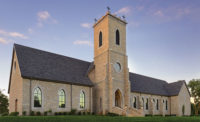
The landscape architect chosen for the project was the Olin Partnership, a firm known for the landscaping of the Getty Center in Los Angeles, and its current work with the Washington Monument. “The design intent for Columbus Circle returns this historic monument to public access and appreciation, fostering an environment not present for a generation,†said E. Allan Spulecki, Associate and Project Manager with Olin Partnership. “The design has been conceived to make the site a safe and attractive addition to the public realm of New York City. The design features - paving, planting, fountains, seating and lighting - all reinforce the simple idea that Columbus Circle is unique in the City.†Other members of the design team from Olin Partnership were Laurie D. Olin, FASLA, who was principal in charge, along with Pi-Chu Liu, Matt Chu, Xiaodi Zheng and Richard Roark. The engineers on the project were Vollmer Associates, LLP and Cosentini Associates.
Stone is an essential material to the new restoration, as the project features more than 18,000 square feet of granite from Polycor. “A central theme of the project was that Columbus Circle is an important place - an icon within the City of New York,†said Spulecki. “The use of granite reinforces the perception of Columbus Circle as a notable civic place - either as a plaza for the residents of the City of New York to gather, or as a fountain and plaza in honor of Christopher Columbus.â€
The small fountain formerly surrounding the monument base was removed, allowing the column base to sit firmly on the ground as the central feature of the circle. People will once more be able to approach it, to read the inscriptions, and to study the relief sculptures on the base more easily than in recent decades. The stone at the base of the fountain was replaced by 100 feet of Stony Creek granite from Polycor, replacing the Stony Creek that was originally installed there when the monument was first built. “Stony Creek was chosen to harmonize with the monument stone color,†said Spulecki.
To replace the loss of the central fountain, new basins using Mesabi Black from Cold Spring Granite have been created that encircle the central open area, designed by Wet Design. “More generous than the former basin and shaped as a series of concentric ledges to form cascades with arching jets towards the center, the new fountains reinforce the circular design and primacy of the monument, while masking the noise of the traffic and tempering the climate in summer,†said Spulecki. “The fountain is designed to form a series of bleacher seats which, when turned off, avoid the forlorn character of so many empty fountain bases in the city, visible during the colder months.â€
The walls and coping around these concentric ledges consist of nearly 6,000 square feet of Deer Isle granite from Polycor. “Deer Isle was specified to contrast in harmony with the Ash Rose granite of the pavers in the plaza, while at the same time, the light pink tones work well with the monument stone colors,†said Spulecki. “Ash Rose was chosen to blend in with the existing buildings and context around the 'outer circle' of Columbus Circle.â€
The specifications of the stone and the pieces required did lead to some fabricating challenges. “This was not a run-of-the-mill project to fabricate,†said Tom Donlan, Mid-Atlantic Regional Manager for Polycor. “The twisting and sloping wall of Deer Isle was very challenging because of the many different angles that were involved.â€
But Donlan said the most complicated part of the project from Polycor's point of view was the radial paving, consisting of roughly 12,000 square feet of Ash Rose from the company. Each of the eight rows of pavers had its own unique specifications, meaning that only a select few could be placed in any particular area. “The radial pavers' layout was very challenging also because of the angles,†said Donlan. “Although it was very detailed, the communications between Professional Pavers, the stone installer, Olin Partnership and Polycor were seamless and without incident.â€
The monument island itself consists of a series of concentric rings that buffer the traffic and provide a pedestrian environment. On the outer perimeter, a ring of raised stone cobbles provides an emerging pedestrian refuge adjacent to the outer vehicular lane, which, in winter, can also accept piles of snow and salt without damage to planting. In addition to applications within the circle, Caledonia from Polycor was also used on the curbs along the street.
“Polycor is very proud to be a part of this project,†said Donlan. “The restoration of this monument was exciting and we were able to meet the design challenges.â€



